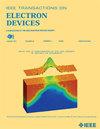Analysis and Characterization Approach of Variation Behavior for Dopant-Segregated Tunnel FETs With Self-Aligned Drain Underlap
IF 2.9
2区 工程技术
Q2 ENGINEERING, ELECTRICAL & ELECTRONIC
引用次数: 0
Abstract
The novel dopant-segregated tunnel FET (DS-TFET) has recently been proposed and experimentally demonstrated as a promising low-power device on standard CMOS baseline platform. In this article, for high-volume production, we evaluate the variation behavior of DS-TFET and carefully study its physical mechanism. Different from conventional TFET, the doping gradient of tunnel junction (TDG) and the electrical length of drain underlap region (自对准漏极下包掺杂偏析隧道场效应管变化特性分析与表征方法
新型掺杂隔离隧道场效应管(DS-TFET)是近年来提出的一种新型低功耗器件,并在标准CMOS基准平台上进行了实验验证。在本文中,为了实现量产,我们评估了DS-TFET的变化行为,并仔细研究了其物理机制。与传统的ttfet不同,隧道结掺杂梯度(TDG)和漏极下迭区电长度(${L}_{\text {und}}$)是两个主要的随机变化源,${L}_{\text {und}}$的附加变化导致$\sigma {I}$ on和$\sigma {I}$ off的不对称变化。基于测量和建模的I-V和C-V特性,进一步发展了一种器件级表征方法,以电提取${L}_{\text {und}}$和主要变化源,并通过计算机辅助设计(TCAD)仿真技术对其进行了验证。该方法为变化感知紧凑模型的开发和基于ds - tfet的电路分析铺平了道路,促进了超低功耗TFET-CMOS混合平台的发展。
本文章由计算机程序翻译,如有差异,请以英文原文为准。
求助全文
约1分钟内获得全文
求助全文
来源期刊

IEEE Transactions on Electron Devices
工程技术-工程:电子与电气
CiteScore
5.80
自引率
16.10%
发文量
937
审稿时长
3.8 months
期刊介绍:
IEEE Transactions on Electron Devices publishes original and significant contributions relating to the theory, modeling, design, performance and reliability of electron and ion integrated circuit devices and interconnects, involving insulators, metals, organic materials, micro-plasmas, semiconductors, quantum-effect structures, vacuum devices, and emerging materials with applications in bioelectronics, biomedical electronics, computation, communications, displays, microelectromechanics, imaging, micro-actuators, nanoelectronics, optoelectronics, photovoltaics, power ICs and micro-sensors. Tutorial and review papers on these subjects are also published and occasional special issues appear to present a collection of papers which treat particular areas in more depth and breadth.
 求助内容:
求助内容: 应助结果提醒方式:
应助结果提醒方式:


